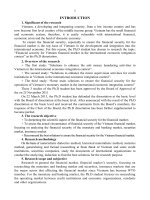Financial accounting in an economic context 8e chapter 07
Bạn đang xem bản rút gọn của tài liệu. Xem và tải ngay bản đầy đủ của tài liệu tại đây (774.13 KB, 28 trang )
1
Chapter 7:
Merchandise Inventory
2
3
Merchandise Inventory
What is inventory?
Items held for resale to customers
Who has inventory?
Wholesaler or Retailer
Merchandise Inventory
Manufacturer
-
Raw Materials
Work in Process
Finished Goods
4
Merchandise Inventory
Acquisition of inventory: What costs to
capitalize?
2. Recording inventory activity: Which
method?
3. Selling inventory: Which cost flow
assumption?
4. Ending inventory: Lower-of-cost-or market
valuation.
1.
5
6
1. Acquiring Inventory
What items or units to include?
– General rule: complete and unrestricted
ownership.
7
Acquiring inventory - contd.
Which costs are included in inventory?
– General rule: all costs associated with purchase or
manufacture, including shipping to facility.
– Freight-in (transportation-in) adds to the
cost of inventory.
– Purchase returns reduce the cost of
purchases (contra) for returned inventory.
– Purchase allowances reduce the cost of
purchases (contra) for reduced prices due to
damage or errors.
– Purchase discounts from early cash
payments (contra) reduce the cost of
purchases.
8
2. Perpetual Method
Figure 7.3: Perpetual System
December 10 Purchase of 100 units @ $20:
Inventory
2,000
Accts. Pay.
2,000
December 20 Sale of 50 units @ $30:
Cash
1,500
Sales
1,500
COGS
1,000
Inventory
1,000
December 30 AJE to recognize loss of 5 units @$20
each (170 on hand, books show 175)
Loss
100
Inventory
100
9
Class Exercise E7-6
Sales
Cost of Goods
Sold (COGS):
BI
Purchases
GAS
Less: EI
COGS
Gross Profit
2008
$1,262
$268
857
$1,125
239
2007
$1,277
$287
887
$1,174
268
886
$376
906
$371
10
E7-6
Assume that counting errors caused the
ending inventory (EI) in 2007 to be
understated by $50 and the ending
inventory in 2008 to be overstated by $50.
Compute the impact of these errors on cost of
goods sold for the year ended December
31, 2007 and on the inventory balance as
of December 31, 2007.
a.
11
E7-6
b. Compute the impact of these errors on cost
of goods sold for the year ended December
31, 2008 and on the inventory balance as of
December 31, 2008.
c. What is the impact of these errors on cost
of goods sold over the two-year period
ended December 31, 2008?
12
E7-6
a. Error in Ending Inventory in 2007: The
$50 understated error in the Ending
inventory means that the Ending Inventory
should have been $268 + $50 = $318. This
would change the Cost of goods sold to
$1,174 - $318 = $856 which would then
increase the Gross profit to $421 ($1,277 $856).
13
E7-6
b.
Error in Ending Inventory in 2008: =
The 2007 error in the Ending Inventory
changes the Beginning Inventory in 2008
and the Goods Available for sale to $318 +
$857 = $1,175. To calculate the Cost of
Goods Sold the Ending Inventory for 2008 is
deducted from the revised Goods Available
for Sale: $1,175 – ($239 - $50) = $986. The
gross profit would then be $1,262 - $986 =
$276.
14
E7-6
c.
2008
Original CGS
$886
Corrected CGS
$986
2007
$906
$856
15
3. Cost Flow Assumptions
Given: BI + P (net) = EI + COGS
How to assign costs of inflows [BI +
P(net)] to EI and COGS?
Methods:
Specific identification
Average for both COGS and EI
FIFO - (first-in, first-out) for COGS
– and LISH (last-in, still here) for EI
LIFO - (last-in, first-out) for COGS
– and FISH (first-in, still here) for EI
16
International Perspective – Cost Flow
Assumptions
Under IFRS the LIFO method is prohibited.
This poses an important potential impediment to
the adoption of IFRS in the US. Most LIFO
users in the US have chosen LIFO because it
results in an income tax savings.
DuPont, for example, has saved over $150
million in income taxes because it uses LIFO.
A shift to IFRS could impose a huge and
immediate tax burden on LIFO users in the US.
17
Cost Flows
18
Cost Flows - Average
19
Cost Flows - FIFO
20
Cost Flows - LIFO
21
Cost Flows – Effects on Financial Statements
22
Cost Flows – Effects on Federal Income Taxes
23
Choosing an Inventory Cost Flow Assumption:
Trade-Offs
Income and Asset Measurement
Economic Consequences
– Income Taxes and Liquidity
– Bookkeeping Costs
– LIFO Liquidation and Inventory Purchasing
Practices
– Debt and Compensation Practices
– The Capital Market
24
Ending Inventory: Applying the Lower-of-Cost-orMarket Rule
Applying the lower-of-cost-or-market rule to
ending inventory is accomplished by comparing
the cost allocated to ending inventory with the
market value of the inventory. If the market value
exceeds the cost, no adjustment is made and
the inventory remains at cost. If the market value
is less than the cost, the inventories are written
down to market value with an adjusting journal
entry.
25









